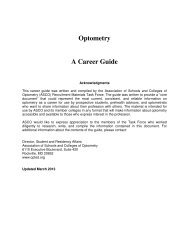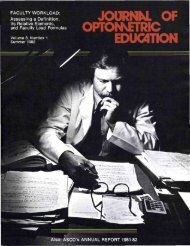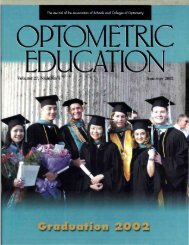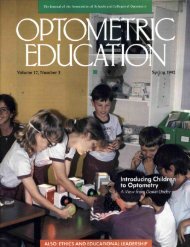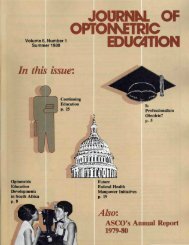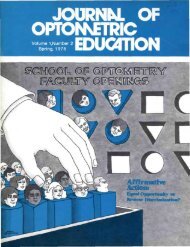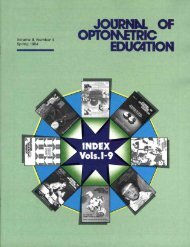Summer 2012, Volume 37, Number 3 - Association of Schools and ...
Summer 2012, Volume 37, Number 3 - Association of Schools and ...
Summer 2012, Volume 37, Number 3 - Association of Schools and ...
You also want an ePaper? Increase the reach of your titles
YUMPU automatically turns print PDFs into web optimized ePapers that Google loves.
the eye clinic staff would be available<br />
for her. Table 2 lists the findings for the<br />
urgent care visit.<br />
Phone conversation with patient:<br />
May 4, 2011, 9 a.m.<br />
The patient was called the following<br />
morning. She reported feeling “okay”<br />
but was very anxious about her condition.<br />
She indicated she had transportation<br />
to the hospital <strong>and</strong> assured the clinician<br />
she would comply. The patient<br />
was reassured <strong>and</strong> reminded <strong>of</strong> the importance<br />
<strong>of</strong> proper testing <strong>and</strong> diagnosis.<br />
The patient was reminded that she<br />
could call the eye clinic or the clinician<br />
at any time to ask questions or to get<br />
information or help facilitating followup<br />
appointments. Table 3 lists the findings<br />
for the ER visit.<br />
Phone conversation with patient:<br />
May 5, 2011, 11 a.m.<br />
The patient reported being discharged<br />
from the hospital earlier in the morning.<br />
The patient reported being given<br />
medication for her condition <strong>and</strong> that<br />
the ER physician spoke to her about the<br />
importance <strong>of</strong> taking the medication to<br />
prevent loss <strong>of</strong> vision. She was given an<br />
appointment by the ER staff with the<br />
attending neurologist for the next day.<br />
The patient was informed that the eye<br />
clinic would schedule an appointment<br />
with a neuro-ophthalmologist within<br />
2 weeks for follow-up. The patient reported<br />
“not feeling well.” The patient<br />
felt tired <strong>and</strong> weak <strong>and</strong> was told by the<br />
hospital staff to spend the day resting.<br />
Appointment with neurologist:<br />
May 6, 2011<br />
The neurology appointment was initiated<br />
<strong>and</strong> scheduled by the ER personnel.<br />
The neurologist confirmed the diagnosis<br />
<strong>and</strong> treatment plan initiated in<br />
the ER. The patient now reported to the<br />
neurologist extreme side effects from<br />
the medication. The patient reported<br />
an inability to walk, disorientation <strong>and</strong><br />
feeling weak. The neurologist told the<br />
patient to discontinue the medication<br />
<strong>and</strong> keep the neuro-ophthalmology appointment,<br />
which was scheduled for<br />
May 17, 2011.<br />
Phone conversation with patient:<br />
May 8, 2011<br />
The patient was extremely distraught.<br />
She was suffering side effects from the<br />
medication given to her by the ER phy-<br />
Constitution<br />
Skin<br />
Head<br />
Cardiovascular<br />
Respiratory<br />
Neurology<br />
Psych<br />
Blood pressure (sitting position, right<br />
arm, large cuff)<br />
Impression<br />
Alert, no acute distress<br />
Normal turgor, color, no bruising<br />
Atraumatic, normocephalic<br />
No murmers, no gallops<br />
Clear to auscultation<br />
Cranial nerves II-XII intact, DTRs normal, sensation intact<br />
Within normal limits<br />
192/136 mmHg<br />
Uncontrolled hypertension<br />
Bilateral optic nerve edema<br />
Treatment/management Clonidine 0.2 mg po x 1<br />
Extensive patient education on the importance <strong>of</strong> blood pressure<br />
control<br />
Follow-up in ER in the morning<br />
Neuro-ophth follow-up, PCP 1-2 days<br />
Medical history<br />
Physical examination<br />
Lumbar puncture<br />
MRI<br />
Impression<br />
Plan<br />
Table 2<br />
Urgent Care Visit: May 3, 2011, 8 p.m.<br />
Table 3<br />
Emergency Room Visit: May 4, 2011, 10 a.m.<br />
Hypertension, obesity, asthma <strong>and</strong> depression<br />
No systemic causes found for increase in cerebrospinal fluid<br />
(CSF) pressure<br />
Opening pressure 320 mm <strong>of</strong> water, closing pressure 150 mm<br />
water, clear yellow fluid obtained<br />
CSF sent for analysis <strong>of</strong> cell count, chemistry <strong>and</strong> gram staining<br />
CSF cytology report subsequently found to be normal<br />
Within normal limits, no space-occupying lesions or obstructions<br />
IIH<br />
sician. Despite experiencing extreme<br />
side effects <strong>and</strong> getting the okay from<br />
the neurologist to discontinue the medication,<br />
the patient was still taking the<br />
medication. The patient reported being<br />
told in the ER that taking the medication<br />
was important because <strong>of</strong> the potential<br />
<strong>of</strong> losing vision. The patient reported<br />
that her appointment with the<br />
neurologist was very quick <strong>and</strong> she felt<br />
she did not have adequate time to ask<br />
the doctor questions. Despite several attempts,<br />
she was unable to contact her<br />
PCP at the community health center.<br />
In order to help the patient, eye clinic<br />
personnel took the following steps:<br />
• The patient’s PCP was contacted<br />
via the electronic medical records<br />
flagging system, informed <strong>of</strong> the<br />
patient’s desire to speak with him,<br />
Admission to hospital<br />
Acetazolamide 250 mg qid by mouth<br />
Follow-up with neurologist after discharge<br />
<strong>and</strong> alerted to her recent health issues.<br />
(There was no record <strong>of</strong> any<br />
communication between the ER or<br />
urgent care staff <strong>and</strong> PCP.)<br />
• The patient was instructed to call<br />
the neurologist to discuss the side<br />
effects <strong>of</strong> the medication <strong>and</strong> possible<br />
visual consequences <strong>of</strong> discontinuing<br />
it. The patient was reassured<br />
that she was not bothering<br />
the neurologist <strong>and</strong> needed to get<br />
her questions answered. The patient<br />
declined the eye clinic’s <strong>of</strong>fer<br />
to contact the neurologist.<br />
• The neuro-ophthalmology appointment<br />
was scheduled for 14<br />
days after the patient’s initial visit<br />
to the clinic. Rescheduling it to a<br />
sooner date was attempted but not<br />
possible.<br />
Optometric Education 118 <strong>Volume</strong> <strong>37</strong>, <strong>Number</strong> 3 / <strong>Summer</strong> <strong>2012</strong>





